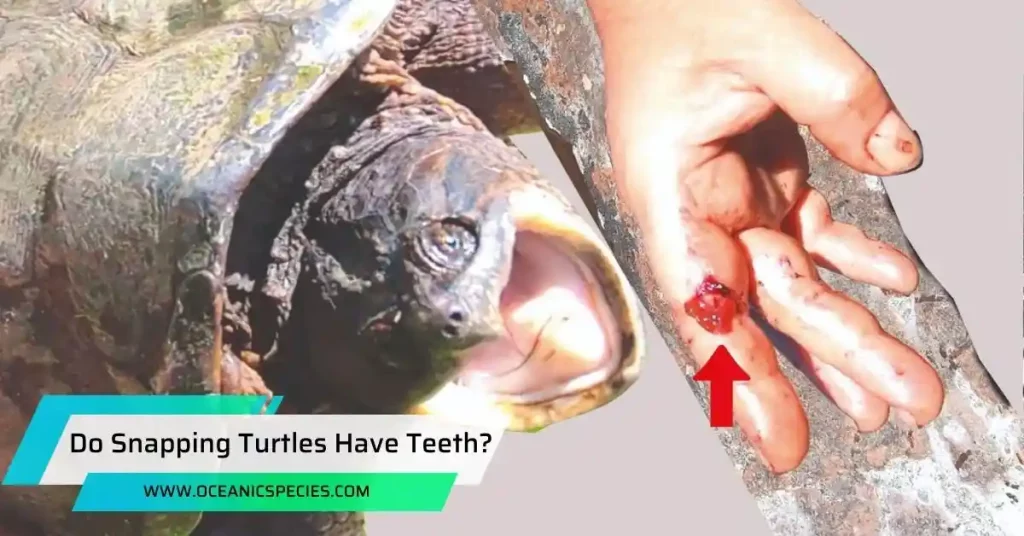Snapping turtles do have teeth; common snapping turtles have an average bite force of about 209 Newtons of force, while alligator snapping turtles have a little less forceful bite, averaging about 158 Newtons of force. Their upper mandible makes for a dandy cutting tool for biting through bones.
These turtles are known for their ability to bite painfully hard, even as babies. This article explores the dental characteristics of snapping turtles and provides insights into their biting capabilities. It also addresses the misconception that snapping turtles do not have teeth, offering an accurate understanding of their dental structure.
Snapping Turtles And Their Powerful Jaws
Snapping turtles do not have teeth, but they have powerful jaws that can deliver a painful bite. Their upper mandible is strong enough to cut through bones, making them formidable predators in their aquatic habitats.
Snapping turtles are well-known for their powerful jaws and fierce nature. These fascinating creatures possess unique anatomical features that enable them to be formidable predators in their ecosystem. In this section, we will explore the anatomy of snapping turtles and the significance of their jaws in maintaining the ecological balance.
Overview Of Snapping Turtles’ Anatomy

When discussing the anatomy of snapping turtles, it is crucial to consider their amazing jaw structure, which plays a vital role in their hunting and survival capabilities. Here are some key aspects of their anatomy:
Powerful Jaws: Snapping turtles possess incredibly strong jaws that allow them to deliver powerful bites. Their bite force is among the strongest in the animal kingdom, making them formidable predators.
Sharp Beaks: These turtles have sharp, hooked beaks that help them catch and tear their prey apart.
Serrated Edges: The edges of their jaws are serrated, which assists them in grasping and holding onto their prey with a firm grip.
Long Neck: Snapping turtles have a long, flexible neck that enables them to extend their reach and strike at their prey swiftly.
Do Snapping Turtles Actually Have Teeth?

Snapping turtles do have teeth, and their bite can be quite painful. Even juvenile turtles can deliver a hard bite, thanks to their sharp upper mandible. These turtles are known for their strong jaws and cutting ability, making them formidable predators.
Exploring Snapping Turtles’ Dental Structures
Snapping turtles are fascinating creatures known for their unique adaptations, including their dental structures. Let’s delve into the world of snapping turtles’ teeth and explore their remarkable features.
Sharp Beaks And Jaw Adaptations:
Snapping turtles have sharp beaks that resemble the shape of a bird’s beak. These beaks play a crucial role in their feeding habits and defense mechanisms. The beaks are designed to tear and crush their prey, allowing snapping turtles to consume a wide variety of food, including fish, frogs, insects, and even small mammals. The sharp edges of their beaks enable them to effectively catch and hold onto their prey, making them formidable hunters in their aquatic habitats.
Comparison To Other Turtle Species:
Unlike other turtle species that have teeth, snapping turtles have a unique dental adaptation. Instead of teeth, they have a series of sharp, pointed ridges along the upper and lower jaws. These ridges, called tomial teeth, function similarly to actual teeth and aid in the tearing and gripping of prey. While not true teeth, these tomial teeth are sharp and effective in helping snapping turtles secure and consume their food.
Understanding The Power Of Snapping Turtles’ Bites
Snapping turtles do have teeth, and their bites can be incredibly powerful. Even baby snapping turtles can deliver painful bites, while adult snapping turtles can bite through bones. It’s important to handle them with care due to their formidable jaws.
Snapping turtles are fascinating creatures known for their powerful jaws and fearsome bites. In this section, we will explore the force behind their jaws, compare their bite strength to other animals, and discuss their adaptations for capturing prey.
The Force Behind Snapping Turtles’ Jaws
Snapping turtles possess jaw muscles that allow them to deliver incredibly strong bites. Here’s what you need to know:
- Muscle power: Snapping turtles have well-developed jaw muscles that enable them to snap their jaws shut with astounding force.
- Quick closure: These turtles can close their jaws in the blink of an eye, giving their prey little chance of escape.
- Bite force: On average, the bite force of a snapping turtle ranges from 1000 to 1500 pounds per square inch (PSI). To put that into perspective, a human’s bite force is roughly 150 PSI, making the snapping turtle’s bite significantly more powerful.
- Sharp beak: Snapping turtles possess a sharp beak-like structure formed by their upper and lower jaws. This beak-like structure aids in gripping and tearing prey.
Bite Strength Comparison
To truly understand the power of snapping turtles’ bites, let’s compare their bite strength to that of other notable animals:
Snapping turtle vs. Alligator: The bite force of a large snapping turtle is comparable to that of a small alligator. Both can exert significant pressure, making them formidable predators.
Snapping turtle vs. Human: As mentioned earlier, a snapping turtle’s bite is considerably stronger than a human’s. It is essential to treat these turtles with caution and respect to avoid any potential harm.
Do Snapping Turtles Bite Hurt Humans?

Snapping turtles do have teeth, and their bite can hurt humans. Even juvenile turtles have a strong bite, and their upper mandible is capable of cutting through bones. It’s important to handle these turtles with caution to avoid getting bitten.
The Threat Of Snapping Turtle Bites:
Snapping turtles are known for their powerful jaws and aggressive nature. While they may not actively seek out humans to bite, it’s important to be aware of the potential threat they pose. Here are some key points to consider:
- Snapping turtles have sharp, pointed beaks that can cause significant injury if they bite.
- Their jaws are incredibly strong, capable of exerting a bite force of up to 1000 pounds per square inch (psi).
- It’s important to remember that snapping turtles are wild animals and may bite if they feel threatened or cornered.
Painful Bite Force:
When a snapping turtle bites, it can be an extremely painful experience. Here are some factors to consider regarding their bite force:
- The sharp beak of a snapping turtle can easily pierce through skin, causing deep lacerations and potential damage to muscles and tendons.
- The force exerted by their jaws can fracture bones, especially in smaller animals or fingers and toes of humans.
- Snapping turtle bites can lead to serious infections due to the bacteria present in their mouths.
Snapping Turtles’ Diet And Prey
Snapping turtles are omnivorous creatures, meaning they have a varied diet consisting of both plant and animal matter. They have strong jaws and sharp beaks that allow them to capture and consume their prey effectively. Let’s take a closer look at the nourishment these fascinating creatures require and the variety of food sources they rely on to survive.
Variety Of Food Sources:
Snapping turtles are opportunistic feeders and can consume a wide range of food sources. Here are some of the common items that make up their diet:
- Fish: Snapping turtles have a preference for fish and will actively hunt for them in bodies of water. They can easily catch slow-moving or injured fish.
- Amphibians: Turtles are known to consume frogs, tadpoles, salamanders, and other amphibians. Their sharp beaks help them crush the hard shells of these creatures.
- Insects and invertebrates: Snapping turtles also enjoy munching on insects, worms, snails, and other invertebrates they come across in their habitat.
- Aquatic plants: While they are mainly carnivorous, snapping turtles also consume aquatic vegetation and plant matter such as waterweeds, mosquito ferns, water lettuce, peat moss, and common water hyacinth.
- Small mammals: On occasion, snapping turtles may opportunistically prey on small mammals like mice, rats, or other small creatures that happen to cross their path.
Frequently Asked Questions
Do Snapping Turtles Bite Hurt?
Yes, snapping turtles have a strong bite that can hurt due to their powerful jaws.
How Strong Is The Bite Of A Snapping Turtle?
The bite of a snapping turtle is strong, with an average force of about 209 Newtons.
Can Snapping Turtles Bite Through Bone?
Yes, snapping turtles can bite through bone with their powerful jaws.
What Turtles Have Teeth?
Some turtles, like snapping turtles, have teeth. Snapping turtles have strong jaws and can bite hard.
Conclusion
Snapping turtles do have teeth, although they are not like the teeth you would typically imagine. Instead of sharp, pointed teeth, snapping turtles have a beak-like structure that helps them crush and tear apart their prey. These teeth are hidden within their powerful jaws, allowing them to exert impressive bite force.
Even baby snapping turtles can deliver a painful bite, while juveniles and adults are known for their ability to bite extremely hard. It is important to handle snapping turtles with caution and respect to avoid any potential bites or injuries.
Their strong jaws and sharp beak make them efficient hunters, able to seize and consume their prey. Snapping turtles possess teeth-like structures that enable them to catch and consume their food effectively.


